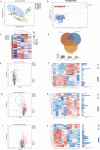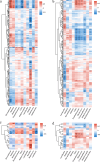The role of gut microbiota-gonadal axis in ovary activation of Asian honey bee (Apis cerana) queens
- PMID: 40483350
- PMCID: PMC12145443
- DOI: 10.1038/s41522-025-00723-9
The role of gut microbiota-gonadal axis in ovary activation of Asian honey bee (Apis cerana) queens
Abstract
The gut microbiota-gonadal axis is increasingly recognized, but its reproductive roles remain unclear. Here, we used the Asian honey bee Apis cerana queens as a model to investigate the role of the gut microbiota-gonadal axis on ovary activation. By artificially caging and releasing the mated queens for a short or long period and monitoring the morphological changes of their ovaries, we confirmed that the activation and suppression of the queen ovary could be switched quickly. We found that the ovary weight was positively correlated with the body weight. 16S rRNA sequencing showed ovarian deactivation reduced gut Lactobacillus abundance. Untargeted metabolomics identified purine metabolism as the dominant ovarian pathway, while correlation analyses implicated Lactobacillus in modulating ovarian morphology through purine signaling. This study elucidates microbiota-gonadal crosstalk governing reproduction, providing mechanistic insights with translational potential for reproductive health management.
© 2025. The Author(s).
Conflict of interest statement
Competing interests: The authors declare no competing interests.
Figures








Similar articles
-
Characterization of gut microbiota in Apis cerana Across different altitudes in the Peninsular India.BMC Ecol Evol. 2025 Apr 29;25(1):39. doi: 10.1186/s12862-025-02349-z. BMC Ecol Evol. 2025. PMID: 40301729 Free PMC article.
-
Distinct gut microbiota profiles of Asian honey bee (Apis cerana) foragers.Arch Microbiol. 2022 Feb 22;204(3):187. doi: 10.1007/s00203-022-02800-5. Arch Microbiol. 2022. PMID: 35192066
-
Early Queen Development in Honey Bees: Social Context and Queen Breeder Source Affect Gut Microbiota and Associated Metabolism.Microbiol Spectr. 2022 Aug 31;10(4):e0038322. doi: 10.1128/spectrum.00383-22. Epub 2022 Jul 18. Microbiol Spectr. 2022. PMID: 35867384 Free PMC article.
-
Gut microbial communities of social bees.Nat Rev Microbiol. 2016 Jun;14(6):374-84. doi: 10.1038/nrmicro.2016.43. Epub 2016 May 3. Nat Rev Microbiol. 2016. PMID: 27140688 Free PMC article. Review.
-
Structural diversity and functional variability of gut microbial communities associated with honey bees.Microb Pathog. 2020 Jan;138:103793. doi: 10.1016/j.micpath.2019.103793. Epub 2019 Oct 15. Microb Pathog. 2020. PMID: 31626917 Review.
References
MeSH terms
Substances
Grants and funding
- 2022GDASZH-2022010102/GDAS' Project of Science and Technology Development
- 32000347/National Natural Science Foundation of China
- 32260863/National Natural Science Foundation of China
- 202103000009/Guangzhou Science and Technology Plan Project
- GIABR-gjrc201702/Talent Project of Guangdong Institute of Applied Biological Resources
LinkOut - more resources
Full Text Sources

